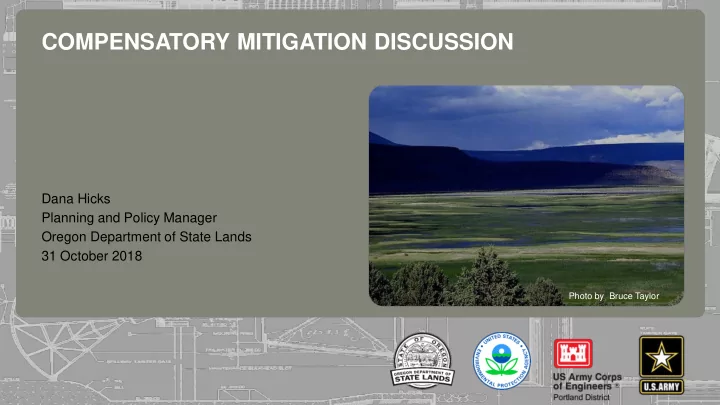

COMPENSATORY MITIGATION DISCUSSION 237 217 200 80 252 83 237 217 200 119 174 36 237 217 200 27 .59 118 255 0 163 131 239 110 112 62 102 130 255 0 163 132 65 135 92 102 56 120 255 0 163 122 53 120 56 130 48 111 Dana Hicks Planning and Policy Manager Oregon Department of State Lands 31 October 2018 Photo by Bruce Taylor
DETERMINATIONS TO ISSUE A PERMIT • The project is consistent with the protection, conservation and best uses of the water resources of the state • The project is the practicable alternative with the least adverse impacts on the water resources • For state-owned submerged or submersible lands, the project does not unreasonably interfere with preservation of waters for navigation, fishery or public recreation Considerations include: Public need Public benefits Alternatives with less impact Sound policies of conservation Public health and safety Conformity with existing public uses Compatible with the local land use Compensatory mitigation for unavoidable, permanent impacts
MITIGATION Reduction of a proposed project’s adverse effects to aquatic resources Mitigation Sequence – Avoid impacts – Minimize impacts – Rectify impacts – Compensate for unavoidable impacts
COMPENSATORY MITIGATION GOALS Replace the functions and values that are lost through the creation, restoration or enhancement of aquatic resources – at an appropriate scale relative to local significance – in a way that is self-sustaining and minimizes long-term maintenance needs – at ecologically suitable locations Functions and Values include: Water quality improvement – filtering and chemical transformations Water storage and delay – storm detention, recharge Habitat for native plant diversity Habitat for fish and wildlife Amenity values for open space, recreation, education Photo courtesy of Ecological Resource Consultants, Inc.
COMPENSATORY MITIGATION OPTIONS Credit purchase – Mitigation bank – In-lieu fee credits Permittee-responsible project Payment in-lieu (DSL only) Credit purchase is preferred for small impacts Applicants always have the option of developing their own mitigation project
MITIGATION BANK A business venture that improves aquatic resources and sells the net benefits as credits Sponsor may be public or private Credits are released over time after achieving performance measures The sponsor sets the price of the credits There are 21 active banks in Oregon and 4 are in- process 6
IN-LIEU FEE Sponsor must be a 501c3 or a government entity; not for profit Advance credits are awarded based on approved compensation planning framework Mitigation project(s) must be approved and constructed within 3 years of a credit sale Credit pricing is pre-approved by the agencies; program financials are reviewed annually DSL is the only ILF sponsor in Oregon 7
SERVICE AREA The geographic area within which credits can be sold Generally align with 4 th order (8-digit) watershed boundaries May include elevation limits Bank service areas may overlap http://www.oregon.gov/dsl/WW/Pages/MitigationMap.aspx 8
WETLAND IMPACT TRENDS, 2000-2016 50% of permanent wetland impact acreage was in the Willamette Valley Upper Willamette = 368 acres Middle Willamette = 180 acres Lower Willamette = 110 acres State Total = 1,287 acres The wetland impact size (per project) has been stable during this time Mean impact = 0.18 acres Average impact = 1.01 acres Lockwood E. 2017 9
COMPENSATORY MITIGATION TRENDS, 2000-2016 Purchase of mitigation bank credits has increased significantly through time Mitigation Bank Credit Purchase Percent of annual CWM projects 2000-2010 = 15% 2011 = 30% 2012 = 62% 2013- 2016 = 56% Causes • New mitigation banks • Federal Rule (2008) preference for compensatory mitigation at banks • Federal Rule (2008) removed on-site preference 10
MITIGATION BANK CREDIT SUPPLY – MIDDLE WILLAMETTE Middle Willamette basin has a 5 year supply based on sales in 2015-2018 2013 Linn-Benton Industrial Land study of 19 sites showed average need of 9.5 credits per year over 20 years -Corvallis Airport Industrial Park has 17.72 credits already approved by DSL and ready for their use Two new banks in-process will add ~100 credits (released over a period of ~5 years) with a mid- Willamette service area 11
REPLENISHING THE CREDIT SUPPLY DSL encourages the development of new mitigation banks and in-lieu fee programs Outreach and presentations Permit streamlining options in rule for small wetland impacts purchasing credits Pre-proposal meetings to review project feasibility and answer questions Templates for required documents Review and Approval Process is in State and Federal rule Establishment takes ~1 year for experience bankers 12
OBSTACLES TO NEW MITIGATION BANKS Requires research to locate suitable sites Land prices are high & rising, the market is competitive, few parcels are listed for sale Bank sponsor (or agent) needs to be knowledgeable about regulations & restoration science, and have project management skills Risks & uncertainties in credit yield, weather, market demand, competition, changes in regulations May need financing for up-front costs such as land investment, consultant costs, and financial security 13
Graph from NorthWest Farm Credit Services – average over 4 states. 14
STRATEGIES TO ENCOURAGE MITIGATION SUPPLY Help communities identify and plan sites for compensatory mitigation projects Communities could put out a Request for Proposals (RFP) for bids to provide credits Communities could sponsor, or co-sponsor, a new bank/in-lieu fee program to share risks and benefits Funding to enable communities to purchase available credits prior to a permitted activity being proposed (limited to public body or public entity at the request of a bank sponsor and approved by Director per rule) -Assure credits are available for private sector projects as well Funding programs may cover some costs to start new mitigation sites -DSL advises any financial subsidy be openly available to all bank sponsors and consider effects on existing mitigation banks – undermining private enterprise would be counter-productive DSL’s In-Lieu Fee Program could expand but viable projects are needed; ORS 196.643 requires DSL limit competition with mitigation banks 15
Dana Hicks Planning and Policy Manager dana.hicks@state.or.us 503-986-5229 www.oregon.gov/dsl Waterways & Wetlands Mitigation
Recommend
More recommend